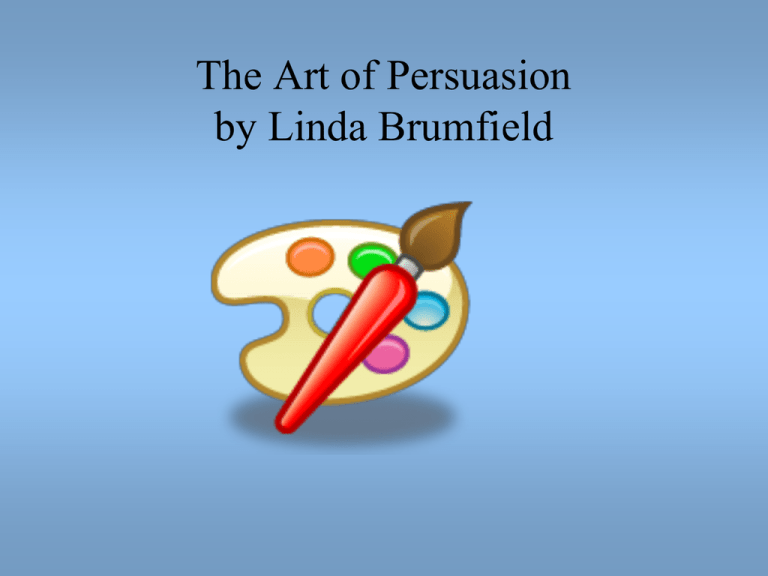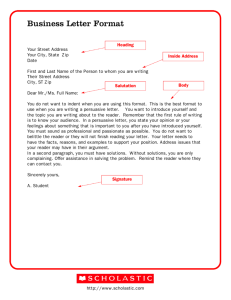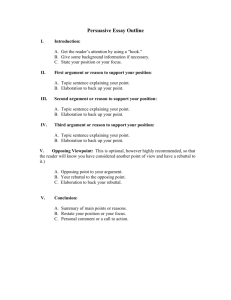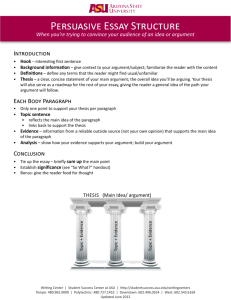
The Art of Persuasion
by Linda Brumfield
• Key Learning: Genre influences organization,
techniques, and style of writing.
• Unit Essential Question: How does genre
influence organization, techniques, and style of
writing.
• Concept: Persuasive Standard: 1.4.5.C.
• Lesson Essential Questions:
– How does an effective persuader influence his/her
readers?
– How do writers select techniques to persuade an
audience?
Persuasive Writing
• In persuasive writing, a writer takes a position FOR or AGAINST an
issue and writes to convince the reader to believe or do something.
• Persuasive writing is often used in advertisements to get the reader to
buy a product. It is also used in essays and other types of writing to
get the reader to accept a point of view. In order to convince the
reader you need more than opinion; you need facts or examples to
back your opinion. So, be sure to do the research!
• Persuasive writing follows a particular format. It has an introduction,
a body where the argument is developed, and a conclusion. After
writing an essay, like any other piece of writing, you should read,
revise, conference and revise, before publishing the final product.
Before starting, check the rubric to see how you will be evaluated, as
well as, all the ingredients required to write the essay.
General Guidelines
•
•
•
•
•
As a general guideline, when writing a persuasive essay:
Have a firm opinion that you want your reader to accept.
Begin with a grabber or hook to get the reader's attention.
Offer evidence to support your opinion.
Conclude with a restatement of what you want the reader
to do or believe.
• Use transitions words - phrases that connect ideas and
show how they are related.
Introduction
•
•
•
•
•
•
•
The introduction should also include a thesis or focus statement.
There are three objectives of a thesis statement:
It tells the reader the specific topic of your essay.
It imposes manageable limits on that topic.
It suggests the organization of your paper.
Through the thesis, you should say to the reader:
"I've thought about this topic, I know what I believe about it, and I
know how to organize it."
• Example Introduction:
• [GRABBER-OPENING WITH A STRONG STATEMENT] Of all the
problems facing the environment today, the one that bothers me the
most is global warming. Some scientists say that the earth is getting
warmer because of the greenhouse effect. [THESIS STATEMENT] In
this paper I will describe the greenhouse effect and whether the earth's
atmosphere is actually getting warmer.
Hooks
•
•
•
•
•
•
•
•
The introduction has a "hook or grabber" to catch the reader's attention. Some
"grabbers" include:
1. Opening with an unusual detail: (Manitoba, because of its cold climate, is not thought
of as a great place to be a reptile. Actually, it has the largest seasonal congregation of
garter snakes in the world!)
2. Opening with a strong statement: (Cigarettes are the number one cause of lighter sales
in Canada!)
3. Opening with a Quotation: (Elbert Hubbard once said , "Truth is stronger than
fiction.")
4. Opening with an Anecdote: An anecdote can provide an amusing and attentiongetting opening if it is short and to the point.
5. Opening with a Statistic or Fact: Sometimes a statistic or fact will add emphasis or
interest to your topic. It may be wise to include the item's authoritative source.
6. Opening with a Question. (Have you ever considered how many books we'd read if it
were not for television?)
7. Opening with an Exaggeration or Outrageous Statement. (The whole world watched
as the comet flew overhead.)
• View Hooks Lesson Plan:
• View Hooks Slideshow
Hook and Thesis
• Write the introduction "hook or grabber” to
catch the reader's attention.
• Write a thesis, or the topic sentence
for the entire piece (the main points
of argument which will be
converted into topic sentences of
paragraphs in the piece).
Body
•
•
•
•
•
•
•
•
•
•
•
•
The Body:
The writer then provides evidence to support the opinion offered in the thesis statement in the
introduction. The body should consist of at least three paragraphs. Each paragraph is based on a solid
reason to back your thesis statement. Since almost all issues have sound arguments on both sides of
the question, a good persuasive writer tries to anticipate opposing viewpoints and provide counterarguments along with the main points in the essay. One of the three paragraphs should be used to
discuss opposing viewpoints and your counter-argument.
Elaboration: Use statistics or research, real-life experiences, or examples. back to top
Generating hypothetical instance: Used particularly when creating an argument and you want the
reader to see a different point of view. Use cues for the reader. (eg.: suppose that, what if...)
Clarifying a position: Think about what needs to be explained and what can be assumed.
Thinking through a process: Think through the procedure from start to finish. Most often the sentence
will begin with a verb. Provide background information a reader may need. Illustrate whenever
appropriate. Define special terms used. Use cues for the reader. (e.g..: first, second, next, then etc.)
Drawing comparisons: Choose something similar to what is being explained. Use one of two
patterns: Opposing or Alternating. End with a conclusion. Use cues for the reader.
Making an analysis: You can analyze a problem by looking at the parts and therefore help the reader
to understand.
Drawing an analogy: Use an analogy to explain or elaborate and idea by identifying significant
likenesses between two objects or ideas when otherwise they are quite different. This is helpful when
the comparison is made to something that is familiar to the reader.
Generating hypothetical instance: Used particularly when creating an argument and you want the
reader to see a different point of view. Use cues for the reader. (e.g..: suppose that, what if...)
Conclusion
•
•
•
•
•
The Conclusion:
A piece of persuasive writing usually ends by summarizing the most important
details of the argument and stating once again what the reader is to believe or
do.
Restate your thesis or focus statement.
Summarize the main points: The conclusion enables your reader to recall the
main points of your position. In order to do this you can paraphrase the main
points of your argument.
Write a personal comment or call for action. You can do this:
– With a Prediction: This can be used with a narrative or a cause and effect
discussion. The conclusion may suggest or predict what the results may or may not
be in the situation discussed or in similar situations.
– With a Question: Closing with a question lets your readers make their own
predictions, draw their own conclusions.
– With Recommendations: A recommendations closing is one that stresses the
actions or remedies that should be taken.
– With a Quotation: Since a quotation may summarize, predict, question, or call for
action, you may use a quotation within a conclusion for nearly any kind of paper.
•
Persuasive Outline
•
•
•
•
•
•
•
•
•
•
•
•
•
•
•
•
•
•
•
•
•
. Introduction:
Get the readers attention by using a "hook."
Give some background information if necessary.
Thesis or focus statement.
II. First argument or reason to support your position:
Topic sentence explaining your point.
Elaboration to back your point.
III. Second argument or reason to support your position:
Topic sentence explaining your point.
Elaboration to back your point.
IV. Third argument or reason to support your position:
Topic sentence explaining your point.
Elaboration to back your point.
V. Opposing Viewpoint: (This is optional, however highly recommended, so that the reader will
know you have considered another point of view and have a rebuttal to it.)
Opposing point to your argument.
Your rebuttal to the opposing point.
Elaboration to back your rebuttal.
VI. Conclusion:
Summary of main points or reasons
Restate thesis statement.
Personal comment or a call to action.
Using a Graphic Organizer:
• www.readwritethink.org/materials/persuasion_
map/ - 4k • Go online, complete, and print the completed
persuasive map organizer
Persuasive Strategies
Copyright 2006 IRA/NCTE. All rights reserved.
ReadWriteThink.org materials may be reproduced for educational purposes.
Images ©2006 Microsoft Corporation. All rights reserved.
Claim
State your argument.
Example: I am going to
try to convince you that
chocolate is a healthy
snack.
Big Names
Important people or experts can
make your argument seem more
convincing.
Example: Former U.S.
president Bill Clinton
thinks that junk food
should be taken out of
vending machines.
Logos
Facts, numbers, and information
can be very convincing.
Example: A
Snickers bar has
280 calories and 30
grams of sugar.
That’s not very
healthy.
Pathos
Getting people to feel happy, sad,
or angry can help your argument.
Example: Your
donation might just
get this puppy off
the street and into
a good home.
Ethos
If people believe and trust in you,
you’re more likely to persuade
them.
Example: Believe
me! I’ve been there
before. I’m just
like you.
Kairos
Try to convince your audience that
this issue is so important they
must act now.
Example: This is a
one-time offer. You
can’t get this price
after today.
Research
Using reliable research can help
your argument seem convincing.
Example: A recent
study found that
students who watch
TV during the week
don’t do as well in
school.
Observations and Notes
•
•
•
Group members: ___________________________________________________________________
OBSERVATIONS AND NOTES
Check the strategies that group members are using to build their argument. Jot down their reasons in
the Notes section to use as examples later.
–
–
–
–
–
–
–
_____ Claim – Students state what they are trying to convince the audience of
_____ Authorities or “Big Names” – Students cite well-known authorities or experts to get the audience to
believe their argument
_____ Logos – Students use facts, data, statistics, or numbers to support their argument
_____ Pathos – Students appeal to the audience’s emotions
_____ Ethos – Students try to gain the audience’s trust and show their credibility and honesty
_____ Kairos – Students try to build a sense of urgency and convince the audience that they must act now
_____ Research – Students cite research (websites, articles, experts) to build their arguments; they show
graphs, tables, or charts to help persuade
•
Notes
•
•
Copyright 2006 IRA/NCTE. All rights reserved.
ReadWriteThink.org materials may be reproduced for educational purposes.
•
•
•
•
•
•
•
•
•
•
•
•
•
•
•
•
•
•
•
•
Name: ___________________________________ Date: ________________________
CHECK THE STRATEGIES
Take another look at the persuasive piece that you chose to share with the class from the
Persuasion Is All Around You assignment. What strategies does the author use to try to
persuade you? Read through each strategy and decide whether the author used that
strategy by writing yes or no in the second column. If you write yes, then explain how
the author used that strategy.
Persuasive Strategy
Yes/No How the Author Used It
Claim – States the main
point or stance
Big Names – Mentions experts and important people to support the argument
Logos – Uses logic, numbers, or
facts to support the argument
Pathos – Appeals to the audience’s emotions
Ethos – Tries to build trust and credibility
Kairos – Builds a sense of urgency
for the cause
Research – Uses studies and
information to make the
argument seem more convincing;
this can be in the form of words,
graphs, tables, or illustrations
Strategy checklist.pdf
Copyright 2006 IRA/NCTE. All rights reserved. ReadWriteThink.org materials may be
reproduced for educational purposes.
Images ©2006 Microsoft Corporation. All rights reserved.
Using a Graphic Organizer
• Complete the map for the persuasive piece online and
print a copy
• Try this map:
Peer Conferencing
•
•
•
•
•
•
•
•
•
•
•
•
•
•
•
Conferencing with a Peer
Ask someone to read your rough draft to see if they understand and can follow your argument. You
may want to put your draft up on the Internet for other students to respond also. Ask them to consider
the following questions. (copy them and paste them at the end of your essay.) Their answers should
show you that your argument makes sense. back to top
What is the thesis statement?
How is the thesis explained?
What are the main points of the argument? (3)
1.
2.
3.
How did the author back up each point?
1.
2.
3.
What are the opposing point(s)?
What is the writer's solution?
back to top
Final Copy
•
Final Copy
• Make the final content revisions as suggested by your peers and
teacher. Check the mechanics and make those changes. Now you
are ready to publish! Will it be published on the Internet, in a
school magazine or newsletter, in a class newspaper or are you
printing it out for the teacher to read? If you are publishing on
the Internet be sure to include your email address so that you can
get some responses.







